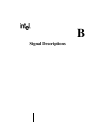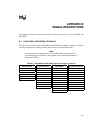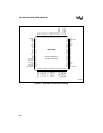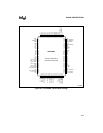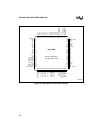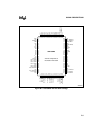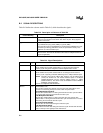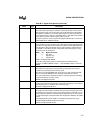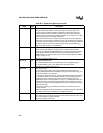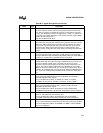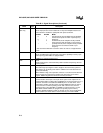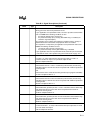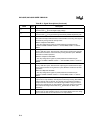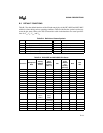
8XC196NP, 80C196NU USER’S MANUAL
B-6
B.2 SIGNAL DESCRIPTIONS
Table B-2 defines the columns used in Table B-3, which describes the signals.
Table B-2. Description of Columns of Table B-3
Column Heading
Description
Name Lists the signals, arranged alphabetically. Many pins have two functions, so
there are more entries in this column than there are pins. Every signal is
listed in this column.
Type Identifies the pin function listed in the
Name
column as an input (I), output
(O), bidirectional (I/O), power (PWR), or ground (GND).
Note that all inputs except RESET# are
sampled inputs
. RESET# is a level-
sensitive input. During powerdown mode, the powerdown circuitry uses
EXTINT
x
as a level-sensitive input.
Description Briefly describes the function of the pin for the specific signal listed in the
Name
column. Also lists the alternate fuction that are multiplexed with the
signal (if applicable).
Table B-3. Signal Descriptions
Name Type Description
A15:0 I/O System Address Bus
These address lines provide address bits 0–15 during the entire external
memory cycle during both multiplexed and demultiplexed bus modes.
A19:16 I/O Address Lines 16–19
These address lines provide address bits 16–19 during the entire external
memory cycle, supporting extended addressing of the 1 Mbyte address space.
NOTE: Internally, there are 24 address bits; however, only 20 address lines
(A19:0) are bonded out. The internal address space is 16 Mbytes
(000000–FFFFFFH) and the external address space is 1 Mbyte
(00000–FFFFFH). The device resets to FF2080H in internal ROM or
F2080H in external memory.
A19:16 are multiplexed with EPORT.3:0.
AD15:0 I/O Address/Data Lines
The function of these pins depend on the bus size and mode. When a bus
access is not occurring, these pins revert to their I/O port function.
16-bit Multiplexed Bus Mode:
AD15:0 drive address bits 0–15 during the first half of the bus cycle and drives
or receives data during the second half of the bus cycle.
8-bit Multiplexed Bus Mode:
AD15:8 drive address bits 8–15 during the entire bus cycle. AD7:0 drive
address bits 0–7 during the first half of the bus cycle and either drive or receive
data during the second half of the bus cycle.
16-bit Demultiplexed Mode:
AD15:0 drive or receive data during the entire bus cycle.
8-bit Demultiplexed Mode:
AD7:0 drive or receive data during the entire bus cycle. AD15:8 drive the data
that is currently on the high byte of the internal bus.




